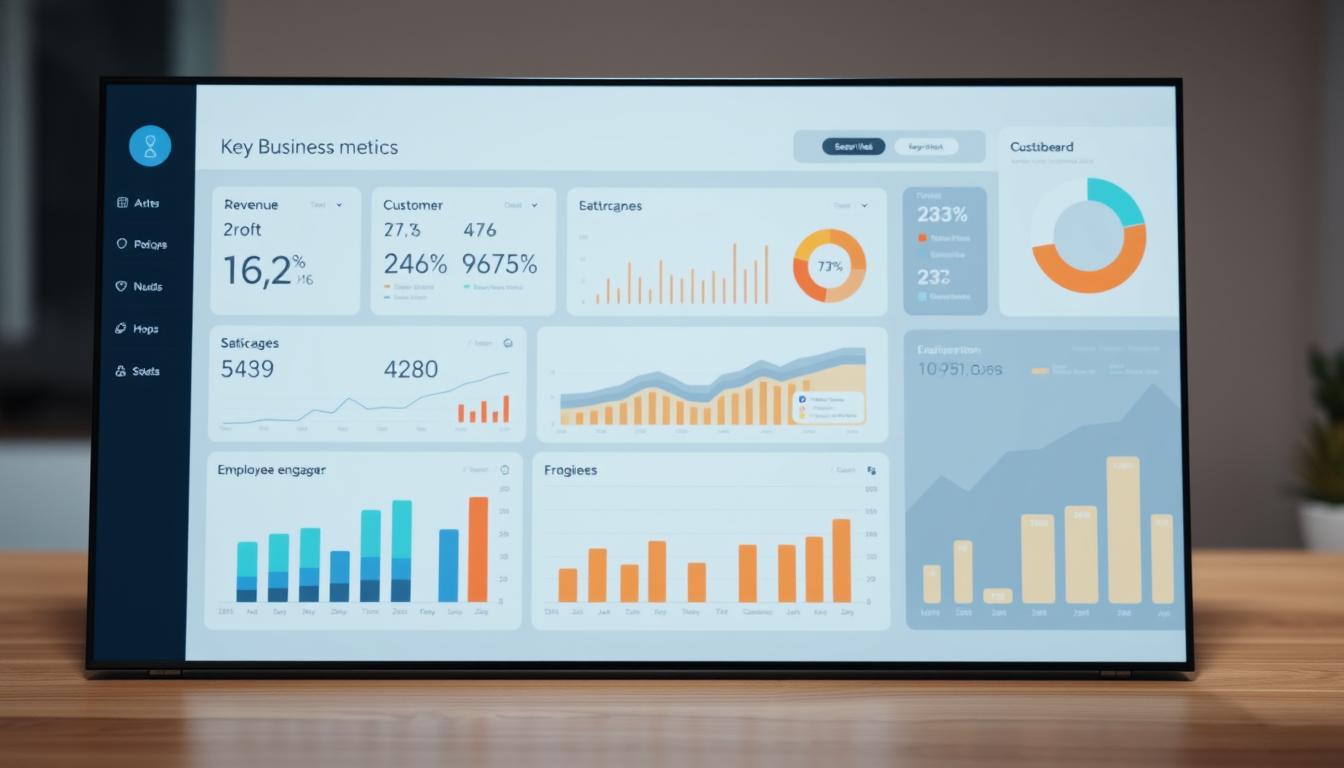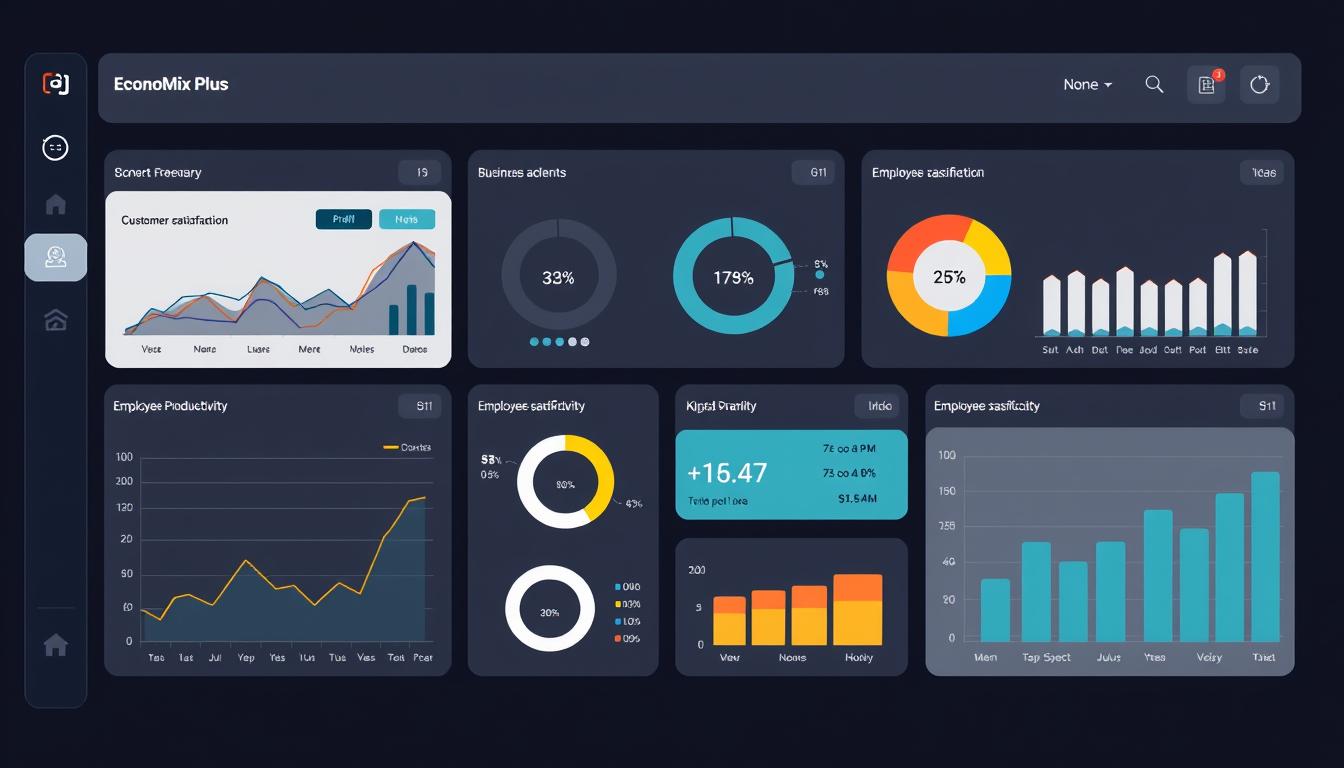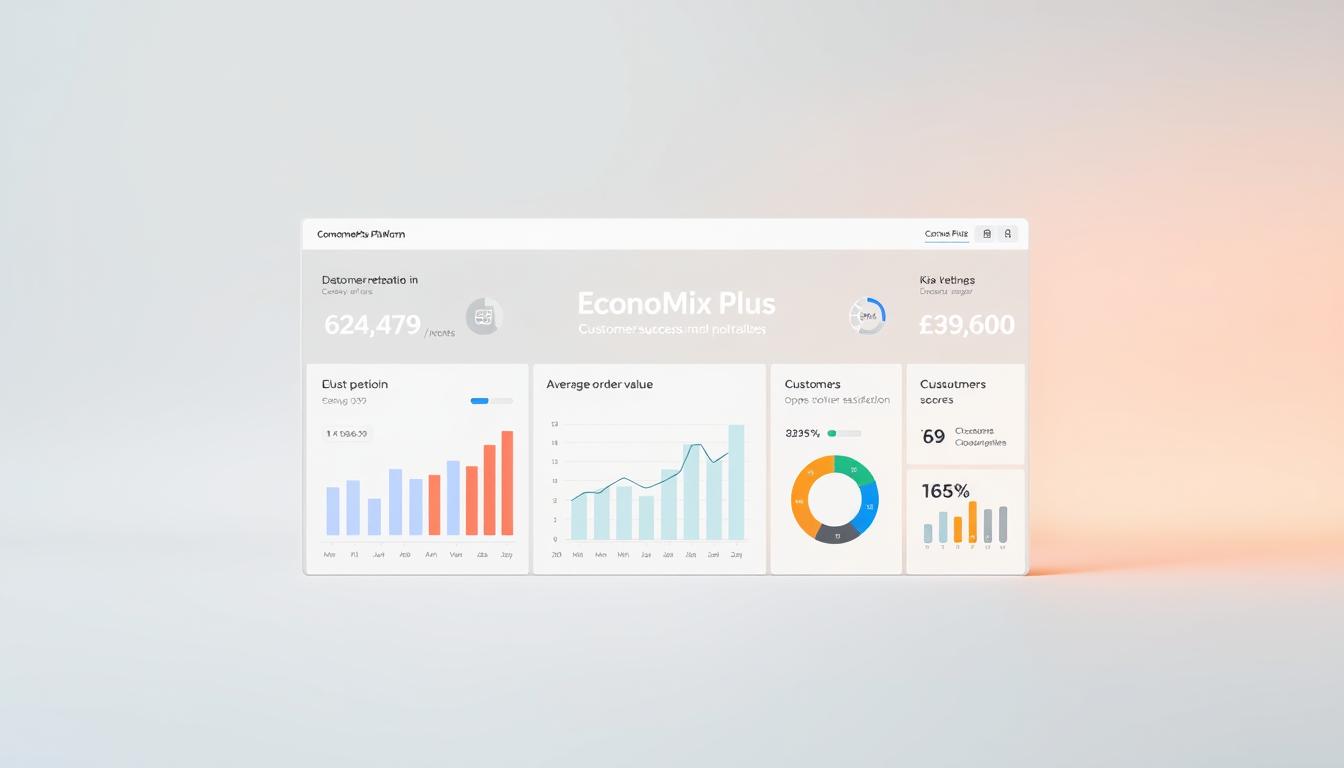When implementing a new business strategy, it’s crucial to identify whether it’s working or not. The most effective way to ensure your strategy is on track is by setting clear success metrics beforehand.
These metrics provide a quantifiable way to measure your progress and gauge the effectiveness of your strategy. By doing so, you can make informed decisions and drive your business performance forward.
Understanding how to measure success is vital for sustainable growth and making informed strategic decisions. Effective measurement helps identify strengths, weaknesses, and opportunities for improvement across all operational areas.
Key Takeaways
- Setting clear success metrics is crucial for measuring progress toward your business goals.
- Effective measurement of business performance helps identify areas for improvement.
- Success metrics provide a quantifiable way to track progress and determine strategy effectiveness.
- Measuring success properly allows for data-driven decision-making.
- Aligning team efforts and creating accountability is vital for achieving business objectives.
Understanding the Importance of Business Success Metrics
Measuring business success is not just about tracking numbers; it’s about understanding the metrics that drive your company’s goals. To achieve success in your business venture, you need to be able to measure performance effectively.
This involves not only identifying the right metrics but also regularly analyzing them to ensure they align with your strategic objectives. By doing so, you can gain insights into your operations and make informed adjustments that enhance your overall performance.
Why Measuring Performance Matters
Measuring performance matters because it allows you to gauge whether your strategy is working. By tracking key metrics, you can identify areas for improvement and make data-driven decisions. This helps you to optimize your business performance and achieve your goals.
- Every metric you track should directly connect to one or more of your core business goals.
- Effective goal-setting begins with identifying your business‘s strategic objectives.
Connecting Metrics to Business Goals
Connecting metrics to business goals is crucial for success. The SMART framework (Specific, Measurable, Achievable, Relevant, Time-bound) provides an excellent structure for doing so. By using this framework, you can ensure that your metrics are aligned with your goals and are driving meaningful results.
- The SMART framework helps you create clear and actionable metrics.
- Regularly reviewing the relationship between your metrics and goals ensures your measurement system evolves with your business strategy.
Essential Financial Metrics to Track
Tracking the right financial metrics can make or break your business strategy. To ensure your business is on the path to success, you need to monitor and analyze key financial indicators. This involves understanding various financial metrics that provide insights into your business’s performance. These metrics not only reflect your current financial health but also help forecast future growth and sustainability.
For instance, analyzing trends in revenue, expenses, and profitability can reveal critical patterns that inform decision-making. By closely observing these indicators, you can identify strengths to leverage and weaknesses to address, ensuring a proactive approach to your business strategy.
Revenue and Profit Margins
Revenue and profit margins are crucial financial metrics that indicate your business’s financial health. Revenue refers to the total income generated from sales, encompassing all the money received from customers for goods or services provided. It is essential to track revenue over time, as it reflects the effectiveness of your sales strategies and market demand. Meanwhile, profit margins represent the percentage of revenue that remains as profit after deducting costs, including both fixed and variable expenses.
Understanding your profit margins is vital, as they provide insight into how efficiently your business is operating and how much profit you retain from each sale. Monitoring these metrics helps you understand your business’s ability to generate income and maintain profitability.
Additionally, by analyzing fluctuations in revenue and profit margins, you can identify trends that may signal changes in market conditions or consumer behavior, allowing you to make informed adjustments to your business strategy.
Cash Flow and Working Capital
Cash flow is the lifeblood of any business, representing the inflow and outflow of cash over a specific period. Working capital, on the other hand, is the difference between your current assets and liabilities, indicating your business’s liquidity and ability to meet short-term obligations. Managing cash flow and working capital effectively is vital for maintaining operational stability.
Return on Investment (ROI)
Return on Investment (ROI) measures the return generated by an investment compared to its cost. It’s a critical metric for evaluating the effectiveness of your investments and making informed decisions about future investments.
To calculate ROI, you typically subtract the initial cost of the investment from the final value of the investment, then divide that number by the initial cost. This formula provides a percentage that can be used to compare the profitability of various investments. A higher ROI indicates a more profitable investment, which is essential for guiding resource allocation and prioritizing projects that yield the best financial returns.
Customer Acquisition Cost and Lifetime Value
Understanding Customer Acquisition Cost (CAC) and Customer Lifetime Value (CLV) is essential for developing effective marketing strategies. CAC refers to the cost of acquiring a new customer, while CLV represents the total value a customer brings to your business over their lifetime. Ideally, your CLV should be significantly higher than your CAC to ensure profitability.
To maximize profitability, businesses should focus on reducing CAC and increasing CLV. This can be achieved by optimizing marketing spend, improving customer retention, and implementing effective cross-selling strategies. By monitoring these metrics, you can refine your marketing strategy and improve overall business performance.
Key Non-Financial Metrics for Business Success
Beyond financial indicators, several key non-financial metrics can help you measure business success. These metrics provide insights into various aspects of your company, enabling you to make informed decisions and drive growth. For instance, understanding customer behavior and preferences can lead to better product development and tailored marketing strategies.
Additionally, analyzing employee engagement levels can reveal how motivated your workforce is, which directly impacts productivity and overall company morale. By focusing on these non-financial metrics, you not only gain a comprehensive view of your business’s health but also foster a culture of continuous improvement and innovation.
Customer Satisfaction and Feedback
Customer satisfaction is a critical metric that reflects how well your products or services meet customer expectations. It serves as a key indicator of your business’s performance and long-term viability. Collecting feedback through surveys, reviews, and other channels not only helps you understand customer needs but also enables you to identify specific areas for improvement.
By actively engaging with your customers and soliciting their opinions, you can gain valuable insights into their experiences and preferences. This information is crucial for making informed decisions that enhance your offerings. By prioritizing customer satisfaction, you can enhance loyalty and drive long-term growth, as satisfied customers are more likely to return and recommend your business to others.
Employee Engagement and Satisfaction
Employee engagement and satisfaction are vital to your company’s overall performance. Engaged employees are more productive, innovative, and committed to delivering high-quality results. Regularly measuring employee satisfaction through surveys and feedback sessions can help you identify opportunities to boost morale and retention.
Brand Loyalty and Reputation
Building strong brand loyalty and maintaining a positive reputation are essential for sustained business success. Metrics such as customer retention rates, Net Promoter Score (NPS), and social media sentiment analysis can help you gauge your brand’s reputation and identify areas for improvement.
Customer retention rates indicate how well you keep your existing customers engaged and satisfied, which is crucial because retaining a customer is often less expensive than acquiring a new one. The Net Promoter Score (NPS) serves as a powerful tool to measure customer loyalty by asking how likely customers are to recommend your business to others. This feedback not only highlights your strengths but also uncovers weaknesses that need addressing.
Furthermore, social media sentiment analysis allows you to monitor public perception of your brand in real-time, providing insights into how your marketing efforts resonate with your audience. By leveraging these metrics effectively, you can develop strategies that not only enhance customer satisfaction but also foster a loyal customer base that champions your brand.
Operational Efficiency
Operational efficiency metrics measure how effectively your business converts inputs into outputs. Key metrics include productivity ratios, cycle time, throughput, and quality metrics. By optimizing these processes, you can reduce waste, enhance productivity, and improve overall business performance.

- Monitor productivity ratios to identify opportunities for improvement.
- Reduce cycle time to enhance project delivery speed.
- Optimize throughput to maximize team output.
- Implement quality metrics to ensure high standards.
By focusing on these non-financial metrics, you can gain a more comprehensive understanding of your business’s performance and make data-driven decisions to drive success.
How to Measure Success in Your Business Venture?
Evaluating the success of your business venture requires a comprehensive approach that includes setting clear goals and tracking key performance indicators. To achieve this, you need to establish a robust framework that aligns with your business strategy.
Setting Clear and Measurable Goals
Setting clear and measurable goals is the foundation of any successful business strategy. Your goals should be specific, achievable, relevant, and time-bound (SMART), allowing you to focus your efforts on what matters most. For instance, if your goal is to increase revenue, you might set a target to boost sales by 15% within the next 12 months.
Establishing Key Performance Indicators (KPIs)
Key Performance Indicators (KPIs) are quantifiable measures that reflect your business’s performance in critical areas. To establish effective KPIs, you need to identify the metrics that are most relevant to your business objectives. For example, if customer satisfaction is a priority, you might track KPIs such as customer retention rates or Net Promoter Score (NPS).

Creating a Performance Measurement Framework
A performance measurement framework provides a structured approach to collecting, analyzing, and acting on business metrics. The Balanced Scorecard is a popular framework that integrates financial metrics with customer, internal process, and learning/growth perspectives. By using such a framework, you can ensure a balanced view of your business performance and make informed decisions to drive growth.
| Framework Component | Description | Example Metrics |
|---|---|---|
| Financial Perspective | Focuses on financial performance | Revenue, Profit Margin |
| Customer Perspective | Examines customer satisfaction and loyalty | Customer Retention, NPS |
| Internal Process Perspective | Looks at the efficiency of internal processes | Cycle Time, Process Quality |
| Learning and Growth Perspective | Focuses on innovation and growth capabilities | Employee Training, Innovation Rate |
As Simons notes in Strategy Execution, “The balanced scorecard combines the traditional financial perspective with additional perspectives that focus on customers, internal business processes, and learning and development.” This comprehensive approach helps businesses measure all activities essential to creating value.
Department-Specific Success Metrics
Evaluating the performance of different departments within your organization requires distinct metrics. Each department plays a unique role in achieving the company’s objectives, and understanding their individual contributions is crucial.
To effectively measure success, it’s essential to track department-specific metrics that align with your overall business goals. This alignment ensures that every team is working towards the same strategic outcomes, facilitating a cohesive approach to performance management.
By utilizing tailored metrics, organizations can gain deeper insights into areas such as productivity, efficiency, and customer satisfaction, ultimately driving better decision-making and resource allocation.
Marketing and Sales Metrics
For your marketing and sales teams, key metrics include conversion rates, sales revenue, and customer acquisition costs. Tracking these metrics helps you understand the effectiveness of your marketing campaigns and sales strategies. For instance, a high conversion rate may indicate successful marketing efforts, while a low customer acquisition cost suggests efficient sales processes.
Example Metrics:
| Metric | Description | Target |
|---|---|---|
| Conversion Rate | Percentage of leads converted to sales | 20% |
| Customer Acquisition Cost | Cost of acquiring a new customer | $100 |
| Sales Revenue | Total revenue generated from sales | $10,000 |
Customer Success Metrics
Customer success metrics focus on ensuring customer satisfaction and loyalty. Key metrics include customer retention rates, net promoter scores, and customer feedback. These metrics help you gauge the effectiveness of your customer success strategies and identify areas for improvement.

Operations and Production Metrics
For operations and production teams, key metrics include production efficiency, supply chain reliability, and product quality. Production efficiency refers to the ability to produce goods with minimal waste and maximum output, which is crucial for maintaining competitiveness in the market.
Supply chain reliability measures the consistency and dependability of the supply chain processes, ensuring that materials and products are delivered on time and in the right condition. Product quality encompasses the standards and specifications that products must meet to satisfy customer expectations. Tracking these metrics helps you optimize production processes, reduce costs, and improve product quality.
For example, a high production efficiency rate may indicate streamlined processes, which can lead to faster turnaround times and lower operational costs, while a low defect rate suggests high product quality, ultimately enhancing customer satisfaction and loyalty.
Human Resources Metrics
Human resources metrics measure the effectiveness of your people management practices. Key metrics include employee satisfaction, employee retention rates, and training effectiveness. These metrics help you understand the impact of your HR strategies on employee engagement and business performance. For instance, high employee satisfaction rates may indicate a positive company culture, while low turnover rates suggest effective retention strategies.
Key HR Metrics:
- Employee satisfaction scores
- Employee retention rates
- Time to hire
- Training effectiveness metrics
- Absenteeism rates
Tools and Systems for Measuring Business Performance

In today’s data-driven world, companies need effective tools to measure their performance and make informed decisions. With a vast amount of data available, businesses must leverage the right tools and systems to stay competitive.
To effectively measure business performance, you can utilize various tools and systems that cater to different aspects of your organization. Two key categories of these tools are performance scorecards and dashboards, as well as data analytics and reporting software.
Performance Scorecards and Dashboards
Performance scorecards and dashboards provide a visual representation of your company’s performance, allowing you to track key metrics and make data-driven decisions. These tools enable you to monitor progress toward your strategic objectives and identify areas that require improvement. By using performance scorecards and dashboards, you can align your team’s efforts with your company’s overall goal.
Data Analytics and Reporting Software
Data analytics and reporting software transform raw data into actionable insights, enabling you to measure performance and drive improvement. These tools help you analyze complex data sets, identify trends, and create comprehensive reports. By leveraging data analytics and reporting software, you can gain a deeper understanding of your business performance and make informed decisions to drive growth.
Some examples of data analytics and reporting tools include business intelligence platforms, predictive analytics tools, and custom reporting software. These tools help you consolidate data from multiple sources, forecast future performance trends, and create tailored reports for different stakeholders.
Creating a Culture of Continuous Improvement
Creating a culture of continuous improvement is essential for measuring success and driving long-term business growth. By implementing the right metrics and control systems, you can track the progress of your strategic initiatives seamlessly. This approach transforms performance measurement from a mere reporting exercise into a catalyst for ongoing business growth.
To achieve this, business leaders must commit to data-driven decision-making, using performance metrics as tools for improvement rather than just evaluation. Transparency in sharing performance data across the organization helps align teams around common goals and creates shared accountability. By celebrating successes when performance targets are met, you reinforce the value of measurement and motivate continued improvement efforts.
Effective business performance measurement systems should evolve alongside your business, with regular reviews to ensure metrics remain relevant to current goals and market conditions. By integrating performance measurement into your business’s strategic planning cycle, you create a virtuous loop of goal-setting, measurement, learning, and refinement. For more insights on creating a culture of continuous improvement, visit FasterCapital’s resource on continuous improvement.
By adopting this approach, you can ensure that your business success is not just a one-time achievement but an ongoing journey of refinement and optimization, driven by a well-informed strategy and engaged managers.
FAQ
▶
▶
▶
▶
▶
▶
▶













